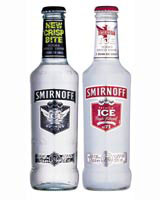Hangover hits flavoured alcoholic drinks market

Summer may have arrived, but one sector that is unlikely to reap the benefits of the warm weather is the once wildly popular flavoured alcoholic beverage market.
FABs – comprising spirit-based mixers, alcopops and wine coolers – have had their day in the sun, according to a Datamonitor report published last week. Sales growth, which reached 27 per cent in 2001, was only 10 per cent last year. More stormy weather lies ahead: the trend monitor forecasts that FAB sales will fall by 23 per cent, to £1.1bn, over the next four years.
‘Young drinkers, who account for 41 per cent of total sales value, are losing their taste for sweet, fizzy drinks,’ claims Datamonitor consumer markets analyst John Band. ‘It now looks like the pre-mixed spirit boom was just a repeat of the mid-1990s alcoholic soft drinks boom.’
Band attributes the sector’s dwindling popularity to its prevalence in supermarkets and off-licences. ‘As pre-mixed drinks have become mainstream, so they’ve become less appealing to discerning consumers. Clubbers [FABs’ original fan base] have switched to drinking white spirits, and cocktails have also made a comeback.’
The FAB’s growing reputation as a ‘girly’ drink, or the sort of libation that only those ‘who don’t like alcohol’ would touch, has also hindered sales.
What can be done to pump some fizz back into this increasingly flat sector? ‘Some kind of product innovation is required,’ says Band, pointing to pre-mixed cocktails as a potentially fruitful, and still relatively virgin, territory. Targeting an older, less trend-driven market, and developing edgier packaging at the same time, could also improve matters.
‘Packaging that doesn’t look sweet, in both senses of the word, would help,’ Band asserts. ‘Smirnoff Black Ice is a good example. Smirnoff Ice was supposed to be the less sweet, unisex FAB. When it took on feminine connotations, [Diageo launched the Landor Associates-designed] Smirnoff Black Ice, with darker packaging and advertising.’
Design Bridge group creative director Graham Shearsby agrees that more stylish packaging could help to revive the sector. Over the past year, he has overseen bottle and label designs for a range of spirit-based mixers, including Sabai (DW 1 July) and Remy Red (DW 30 October 2003), which is set to roll out in the UK later this year.
‘Most [FABs] come in pretty standard bottles, and the packaging does need to be explored and shaken up a bit,’ says Shearsby. This is especially true for a sector that is aimed at a notoriously fickle demographic: 18-to-24-year-old drinkers.
‘If you look at other youth-related brands – such as Lynx, and probably Impulse – they’ve got to recruit and lose an audience every three years,’ he adds. ‘They recognise that you can get 16-year-olds hooked, but once they’re 18, they’ve moved on.’
FABs’ situation is made more troublesome by the choice of alcoholic drinks now on offer. Shearsby points out that a visit to the local bar or pub could now yield a real ale, a fine wine and a range of cocktails, plus traditional fare such as a pint of lager and a packet of crisps.
Yet Shearsby maintains that revamped packaging can only do so much for a sector that burst on to the scene nearly 15 years ago. ‘It’s a mature market now and kind of established. And the drinks market is so cyclical. For instance, there was a cocktail boom in the 1980s, nothing in the 1990s, and now they’re back,’ he says.
‘[FABs] are not going to suddenly go away,’ he observes. ‘But they need to pick up what Lynx has got and keep it fresh.’
Diageo PR manager Paul Flanagan agrees that ringing the death knell for the sector is probably premature. ‘The category is down 11 per cent year-on-year, but in the UK it’s still worth £1.2bn in terms of sales: roughly the same as the vodka market. I think that shows there’s still a very strong consumer base for FABs,’ he says.
-
Post a comment




